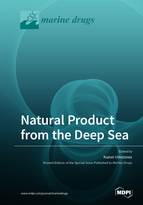Natural Product from the Deep Sea
A special issue of Marine Drugs (ISSN 1660-3397).
Deadline for manuscript submissions: closed (30 October 2021) | Viewed by 21207
Special Issue Editor
Interests: bioactive metabolite screening from micro-organisms and plants; cellular signal transduction; development of anti-inflammatory and anticancer agents
Special Issues, Collections and Topics in MDPI journals
Special Issue Information
Dear Colleagues,
Many scientists have tried to isolate novel and active compounds mainly from micro-organisms, including bacteria, Streptomyces, and fungi, plants, and ordinary marine organisms, since the middle of the 20th century. However, after the long history of screening, it is becoming more difficult to find novel compounds anywhere in the world.
Until now, more than 28,600 marine natural products have been reported. However, with the development on marine natural products research, the hit rate of new compounds is also decreasing. Scientists are turning their attention to the deep sea. By 2008, almost 400 compounds were isolated from deep-sea organisms. By 2013, a further 188 new deep-sea natural products were reported. About 75% of the deep-sea-origin compounds were reported to show biological activity (i.e., 141 of 188 compounds), with almost half (i.e., 81 of 188 compounds) exhibiting potent cytotoxicity in human cancer cell lines [Scropeta et al, 2014].
In addition to the micro-organisms, there are also sponges and corals in the deep sea. An investigation of the extracts of 65 twilight-zone (50–1000 m depth) sponges, gorgonians, hard corals, and sponge-associated bacteria resulted in an extremely high hit rate (42%) of active extracts, with a hit rate for sponge and gorgonian extracts of 72% [Schupp et al, 2009 and Wright et al 2012].
Therefore, deep-sea organisms are important sources of natural products, especially for screening of pharmacologically active compounds. In this Special Issue, I would like to bring together articles on the screening of both new chemicals and bioactive metabolites produced by deep-sea organisms. Articles concerning the timely synthesis and biotransformation of natural products from the deep sea are also welcome. This Special Issue “Natural Products from the Deep Sea” will be useful for the screening of pharmacologically active compounds from nature.
Prof. Dr. Kazuo Umezawa
Guest Editor
Manuscript Submission Information
Manuscripts should be submitted online at www.mdpi.com by registering and logging in to this website. Once you are registered, click here to go to the submission form. Manuscripts can be submitted until the deadline. All submissions that pass pre-check are peer-reviewed. Accepted papers will be published continuously in the journal (as soon as accepted) and will be listed together on the special issue website. Research articles, review articles as well as short communications are invited. For planned papers, a title and short abstract (about 100 words) can be sent to the Editorial Office for announcement on this website.
Submitted manuscripts should not have been published previously, nor be under consideration for publication elsewhere (except conference proceedings papers). All manuscripts are thoroughly refereed through a single-blind peer-review process. A guide for authors and other relevant information for submission of manuscripts is available on the Instructions for Authors page. Marine Drugs is an international peer-reviewed open access monthly journal published by MDPI.
Please visit the Instructions for Authors page before submitting a manuscript. The Article Processing Charge (APC) for publication in this open access journal is 2900 CHF (Swiss Francs). Submitted papers should be well formatted and use good English. Authors may use MDPI's English editing service prior to publication or during author revisions.
Keywords
- natural products
- deep-sea organisms
- isolation
- structure determination
- synthesis
- biotransformation
- biological activities
Related Special Issues
- Deep-Sea Natural Products in Marine Drugs (12 articles)
- Deep-Sea Natural Products II in Marine Drugs (9 articles)
- Natural Products from Deep Sea 2nd Edition in Marine Drugs







